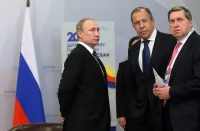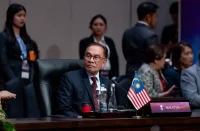It was a given from the outset that the conference of the Non-Aligned Movement (NAM) which convened late August in Tehran would grab the headlines internationally. In an epoch that never sank into oblivion, the organization founded as an alliance of 120 countries by the charismatic trio of Josip Broz Tito, Gamal Abdel Nasser, and Jawaharlal Nehru in 1961 emerged as an influential force capable of maintaining autonomy from both NATO and the Eastern Bloc. Though the NAM membership implied no formal obligations, the partners achieved an impressive level of coordination in resisting neocolonialism and protecting their rights to original development patterns, and the NAM must be credited with having played an appreciable role in making the US tone down military escapades in South East Asia as well as with having provided a crucial backing to the liberation movements across Africa and Latin America.
Steering clear of the bipolar world’s wrestling camps, the NAM peers, to varying extents, subscribed to the ideology of building societies on the foundations of justice and social progress, condemned the Western dictate, and, as necessary, even engaged with the Eastern bloc. The NAM internal mechanics changed following the collapse of the latter and the advent of globalization which replaced the neocolonial agenda with new imperatives. These days, the NAM seems divided, with many of its members – India, Indonesia, Egypt, Saudi Arabia, Afghanistan, Iraq, etc. now solidly in the US orbit and others – Yugoslavia and Libya – undermined and ultimately destroyed by the globalizing world’s leaders. Still others, Romania and Finland, for example, opted out of the NAM as their priorities drifted away from the alliance’s program. From a wider perspective, the rejection of the socialist development model triggered an identity crisis in the NAM, prompting the majority of its members to search for alternative strategies and to switch to diluted forms of involvement with the alliance. The NAM continues to function nevertheless, holds congresses every three years, but is only a shadow of the influence it used to be internationally. The US diplomacy hastily wrote off the NAM as such, and the view that today’s world holds no place for it is pressed by many of the world watchers, but that may prove to be an overstatement. The NAM convention in Tehran drew high-level representatives from 116 countries, among them – 36 presidents, vice presidents, or premiers, plus 80 foreign ministers and special envoys, which is indicative of the alliance’s unwaning importance. By being able to host an event of such proportions, Tehran largely dispelled the US myth that Iran is perceived globally as a rogue country. In fact, at the moment Washington has to realize that its efforts to drum up support for a crackdown on Iran produced no result, considering that only a handful of countries outside of NATO would embrace a ban on the Iranian controversial nuclear program. In contrast, the broad NAM forum slammed the US over its hardline policies and reaffirmed Iran’s right to a peaceful nuclear program including the full enrichment cycle. It is fair to say that NAM’s taking a strong stance on the key issue alone made the conference an international highlight. Iran, it must be noted, is a signatory to the Nonproliferation Treaty and reaffirms commitment to it on every appropriate occasion, while Israel which threatens to bomb the Iranian nuclear installations, has not penned the Treaty and is known to have nuclear arsenals. Tel Aviv recently voiced a new round of threats against Iran, and German chancellor Angela Merkel urged the Israelis to exercise restraint, but the show should not obscure the developing world’s unreceptiveness to the US foreign-policy agenda or eagerness to rely on its own vision in dealing with the Iranian nuclear program and beyond. It increasingly transpires that, as the unraveling of the conflict over Iran’s nuclear program once again showed, the US should adopt a soberer approach to international affairs and at least become aware of the pervasive allergies to its tendencies towards unilateralism and whip-and-carrot games.
A serious debate over Syria erupted at the NAM conference. Divided over the issue, the forum, despite Tehran’s efforts, decided to say nothing about the current Syrian crisis in its final document. The speech delivered by Egyptian President Mohammad Morsi left no doubt that some of the country leaders buy the picture painted by the Western propaganda and fail to grab the essence of what is happening in Syria. In an emotional address, Morsi lambasted B. Assad and asserted that supporting the Syrian opposition was a “moral duty” for the NAM, stressing the continuity between the regime changes in Tunisia, Libya, and Yemen and the looming Syrian transition. As a result, the forum dynamics took a turn unfavorable to Syria. Morsi’s statement attracted indirect criticism from Ayatollah Khamenei, and the Iranian parliament’s Middle East adviser Hossein Sheikholeslam told the Mehr News Agency that Morsi “committed a big mistake by availing himself of his position (as NAM president) and expressing the standpoints of Egypt while ignoring all NAM principles”. Indeed, Assad’s government is completely legitimate and recognized throughout the world, which puts Morsi at odds with the protocol, but it should be further taken into account that the Egyptian leader hails from the Muslim Brotherhood, a group with a curious concept of what liberty should mean for the region. Guerrillas from the Muslim Brotherhood are known to be fighting on the side of the opposition in Syria.
The participation of UN Secretary-General Ban Ki-moon in the conference served to underscore the significance of the event. The US Department of State expressed reservations concerning Ban Ki-moon’s plan to visit Iran, but the tour actually opened up opportunities for meaningful and, in part, unanticipated discussions. While in Tehran, the UN Secretary-General expressed concern over Iran’s alleged nuclear ambitions and human rights problems. Speaking at the Iranian School of International Relations, he told about having demanded the release of Iran’s political convicts during a meeting with Ayatollah Khamenei and also quoted the Iranian leader as saying that the country regards the pursuit of nuclear weapons as deeply sinuous and never had anything like that in mind, meaning that the sanctions slapped on Iran are absolutely groundless. The point made by Ayatollah Khamenei was that the ruthless treatment only reinforces the Iranians’ belief in their cause. He also criticized the structure of the UN Security Council as undemocratic, irrational, and tantamount to a disguised dictatorship enabled to implement its policies “in a bulling manner”. Seeing the situation through Iran’s prism certainly had to give Ban Ki-moon a freshly realistic perspective on the situation. For Tehran, having the UN Secretary-General attending reinforced Iran’s claim to the NAM leadership, a position it surely deserves as the country spearheading the opposition to aggressive globalism.
Tehran clearly accomplished its objectives by hosting the NAM conference which demonstrated that the informal alliance is in the process of overcoming its identity crisis. The sense of cohesion within the NAM is growing, largely on the basis of anti-Americanism, and Iran as the country constantly held at Washington’s gunpoint naturally must be at the helm. Overall, the NAM present-day anti-Americanism reads as a wider anti-Western trend that will be gaining momentum as the world economic crisis rages on and attempts to impose US-style “democracy” on sovereign nations multiply. The forum’s advocacy of Iran’s rights in connection with its nuclear program reflected the position with utmost clarity. It was no coincidence that the NAM conference gathered in Tehran – the member-countries recognize Iran’s leadership potential, and presiding over the alliance in the coming three years, Tehran will do its best to exceed the expectations.
Source: Strategic Culture Foundation














Comments